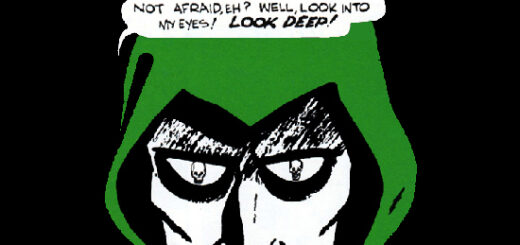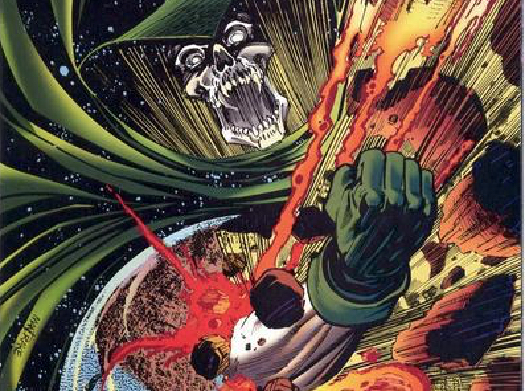John Ostrander: The Spectre – What Was I Thinking?
Halloween was yesterday (if you’re reading this on Sunday); a time of ghosts and ghouls and little children strong arming adults for candy under the threat of “tricks.” Oh, also when the Great Pumpkin rises from a really sincere pumpkin patch to bring toys and presents to good little children all around the world. Or so I have been told.
And, of course, it’s time for ghost stories and horror stories and tales of things that go bump in the night and I’ve told a few of those myself, notably Wasteland. My most successful foray into the genre, though, probably was the run I did on The Spectre with Tom Mandrake for DC Comics back in the 1990s.
The Spectre was an interesting amalgam of both supernatural and superhero. Created in 1940 by Superman creator Jerry Siegel and artist Bernard Baily, the central character was hardnosed plainclothes detective Jim Corrigan who falls afoul of mobsters and is murdered. He’s sealed into a cement filled oil drum and dumped in the river. His soul, however, is unable to rest and an entity called “The Voice” sends him back as a vengeance-seeking ghost, a.k.a. The Spectre.
As the Spectre, Corrigan has unimaginable powers and abilities. And therein lay the problem. The only being more powerful than the Spectre would be God and only on days when God had been eating his Wheaties. How do you mount a credible threat to someone like that? If there is no risk, there’s no suspense and no story. The bad guy does bad things and the Spectre shows up and dispatches him, usually in a grisly fashion.
The Spectre never lasted long in his own series, although there were several attempts. The common wisdom was that you had to reduce the Spectre’s power to make a story. The problem with that was, in so doing, you lost some of the spectacular visuals that made the Spectre what he was. Why bother?
Tom Mandrake and I had been partners for a while, working on GrimJack and then on The Fury of Firestorm. The latter series was ending and we were looking for something new to do together. Both of us were long time fans of the Ghostly Guardian (as the Spectre was known) and campaigned to get to play with him. DC was leery; a recent attempt at doing a Spectre ongoing had been cancelled only a relatively short time before.
“Give him to us,” Tom and I told DC; “We know how to make him work.”
Editor and friend Dan Raspler took up our cause and got DC to agree based on our past track record together and how we pitched our concept for the relaunch.
It wasn’t the Spectre that we changed so much as it was his human counterpart, Jim Corrigan. Different versions of the story resurrected Corrigan and even set him at odds sometimes with the Spectre persona, which had taken up residence in Corrigan’s body. I felt that Corrigan himself had become something of a wimp. So, first of all, Tom and I declared that Corrigan was dead and had been dead since the 1940s. That was his tragedy. Sometimes, he fooled himself into thinking he was alive but he was, in fact, dead.
Second, Corrigan had been a plainclothes police detective back in the 40s. He was hard-boiled. Go back and watch the police movies from back then; hell, go read the early Dick Tracy strips. Hard, tough, and not afraid to use violence and even death to achieve justice. This, we felt, was why he was given the power of the Spectre and informed how that power was used. The Spectre may have had the power of a god but he had the perspective of a mortal man, a very flawed mortal man.
We decided that “The Voice” was short for The Voice of God and the Spectre himself became the Wrath of God. In a way, he was an aspect of God, specifically of Jehovah – and a very Old Testament Jehovah at that. The Spectre had been the Angel of Death that had culled the first born of Egypt. At one point, the Spectre entity rebelled against mercy and so it was decreed it that it had to be united with a human soul in order to walk the Earth, the theory being that the human could temper the Wrath of God. However, when you had a human as liable to rage and outrage as Jim Corrigan, that wasn’t always true.
This enabled us to keep the spectacular visuals and outrageous stunts, the iconography that gave readers a reason to come to the Spectre in the first place and still allow us to construct stories. The Spectre wasn’t vulnerable but Corrigan was.
Corrigan was also weary; since the 1940s he had tried to eradicate evil and the world had only gotten darker. He was very near despair and facing an existential crisis. That also gave us a platform for our stories; we asked questions on the nature of punishment, despair, and redemption. We posed ethical and theological questions. I was less interested in giving answers to those questions, which I felt the readers could and should provide for themselves.
This is all very cerebral. I know. What really made the book sing was Tom’s artwork. This is the character that Tom Mandrake was born to draw and over and over again I looked for situations that played to his myriad strengths. Hey, as they said in The Producers, “When you got it, flaunt it, baby, flaunt it!”
What added to the run were the covers; each issue had a different artist and each artist presented their own interpretation of the character, often telling their own story in one image. Likewise, the letter page (helmed by Peter Tomasi who started as the assistant editor on the book and later became the book’s editor) also delved into the topics raised by the story, creating an interesting discussion between Pete and the reader. All in all, it was quite a package.
We went on for five years and we learned that our run was nearing an end. We were given a year’s notice and permission to wind up the story our way. This is really rare. Corrigan had grown during the run of issues we did and, in our last issue, he gave up being the Spectre to go on to his final reward. That’s also unusual. With that ending, we were able to tie up our entire series and make it all one story. It completed what Tom and I were doing in a way that one rarely gets to do.
Tom and I are playing with the horror genre again as we work on Kros: Hallowed Ground. We’re both very excited by it; this is the first time we’ve played with the horror genre together since The Spectre. Expectations may be high; The Spectre was one of the high-water marks in both our careers. We feel confident but not cocky. The Spectre was very much of its time and where we were in our careers but I think it also stands up today. Two TPBs have been issued from DC gathering some of the early issues; I hope they go on to collect the others as well.
All false modesty aside, I think it’s worth it.














